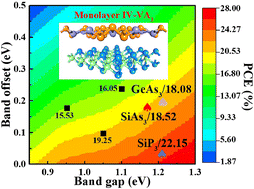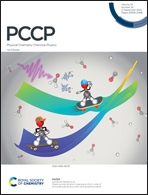Two-dimensional IV–VA3 monolayers with enhanced charge mobility for high-performance solar cells†
Abstract
High-performance photovoltaics (PVs) constitute a subject of extensive research efforts, in which silicon (Si)-based solar cells (SCs) have been widely commercialized. However, the low carrier mobility of Si-based SCs can limit the effective charge separation, thereby negatively impacting the device performance. Here, via calculating the physicochemical and PV performance based on density functional theory, we demonstrate SCs based on two-dimensional (2D) group IV and V compounds with an AX3 configuration. Firstly, the cleavage energies of AX3 (A = Si, Ge; X = P, As, and Sb) are calculated to be less than 1 J m−2, providing an experimental feasibility to be exfoliated from the corresponding bulk. Secondly, electronic and optical properties have been systematically investigated. To be specific, the band gap of monolayer AX3 falls in the range of 1.11–1.27 eV, which is comparable with that of Si. Significantly, the electron mobility of monolayer AX3 can reach as high as ∼30 000 cm2 V−1 s−1, which is one order of magnitude higher than that of Si. Furthermore, the optical absorbance of monolayer SiAs3, SiP3 and GeAs3 exhibits high coefficients in visible light. Therefore, we believe that our designed AX3-based PV systems with power conversion efficiency of 20% can offer great potential in the application of high-performance two-dimension-based PVs.



 Please wait while we load your content...
Please wait while we load your content...